Star Wars: The Arcade Games
Each of the original Star Wars trilogy saw its own arcade cabinet release, as well as the usual ports to consoles. Unlike the previous Star Wars home computer games, these were designed for instant action and replayability to keep those coins rolling in. Apart from the two prequel-related arcade ports, there were three further arcade shooters that followed in the 90s and in 2014, sticking to the same game design to great effect.
All these games follow the same premise: you are sitting in the cockpit of one of the many recognisable Star Wars vehicles, blasting your way through a number of famous scenes from the movies. Aside from in Star Wars: Return of the Jedi, which is a top down view, the formula doesn't change, and as a result you can easily trace gaming history and technology improvements from Star Wars in 1983 through to Star Wars Battle Pod in 2014 (and beyond).
Star Wars
Atari, 1983
Star Wars uses vector graphics as was usual at the time, drawing lines of light on the screen so everything has that wireframe feeling. This was just like Asteroids (Atari, 1979) and Battlezone (Atari, 1980), the first 3D first-person game of which Star Wars is a descendent. What is celebrated now as highly stylised was normal at the time, but it’s hard to deny it looks tremendous even today. It was at the forefront of gaming technology, George Lucas insisting to push the boundaries not only in film but also gaming.
Any Star Wars fan can see why it was a hit at the time, even if you don’t enjoy games from this period. From top to bottom, everything is instantly recognisable from the films. The vehicles, music, synthesised quotes from your favourite heroes and the stories and scenes themselves, all make you feel like you're in Star Wars.
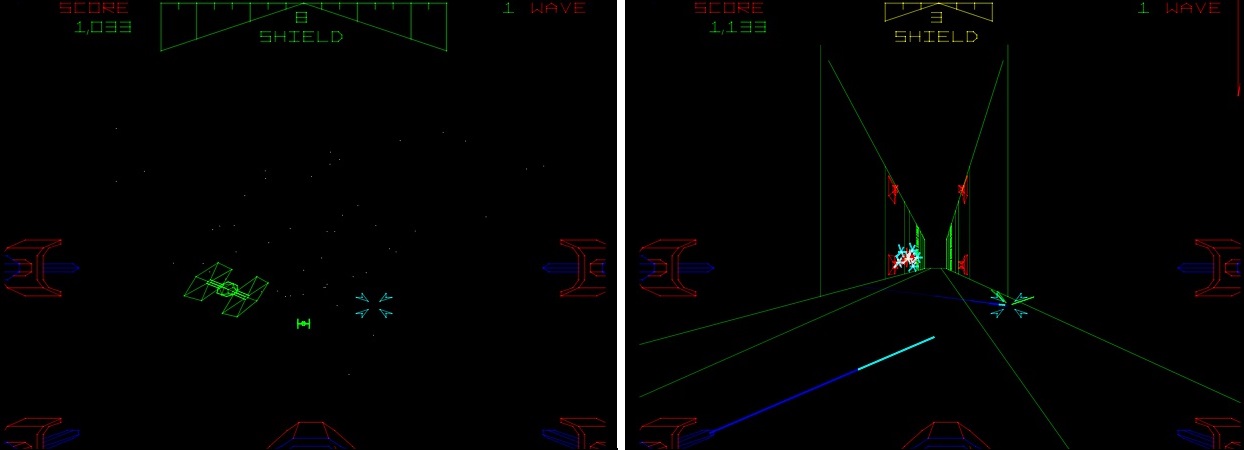
Sitting in your cockpit (unless your arcade had the stand-up version), your X-wing is on-rails as you fly through the levels, although the ship does turn slightly as you aim in different directions. It’s a nice touch giving you the illusion of piloting despite not really being in control. Starting off in space shooting TIE fighters, you then go down to the surface of the Death Star and then into the final trench run. If you succeed, you start again with an increase in difficulty.
Everything is communicated clearly to the player, even on later waves as the difficulty increases. Because of the simplicity and the sheer fun of the shooting gallery, it never gets boring, you’ll be starting again as soon as you get Game Over. In fact all of the arcade games are great for replayability as you would hope for an arcade game designed for people to keep putting coins in. All, that is, except for Return of the Jedi
Star Wars: Return of the Jedi
Atari, 1984
Atari’s next game was not the second film of the trilogy, but Return of the Jedi instead and we don’t really know why. It’s likely that, as the Jedi film was released at the end of 1983, Atari predicted greater success if they could tie the marketing to the latest chapter in the saga.
This is the black sheep of the family, with raster graphics instead of the striking vector graphics of its predecessor. This type of graphics were already used in the early days of arcade machines but were probably quite eye popping in arcades at the time. There was probably not enough processing power to recreate the Battle of Yavin with multiple ships, bombs, lasers, and a huge scrolling background in an impressive way, which is why we have a top down view instead and no cockpit for the player to sit in.
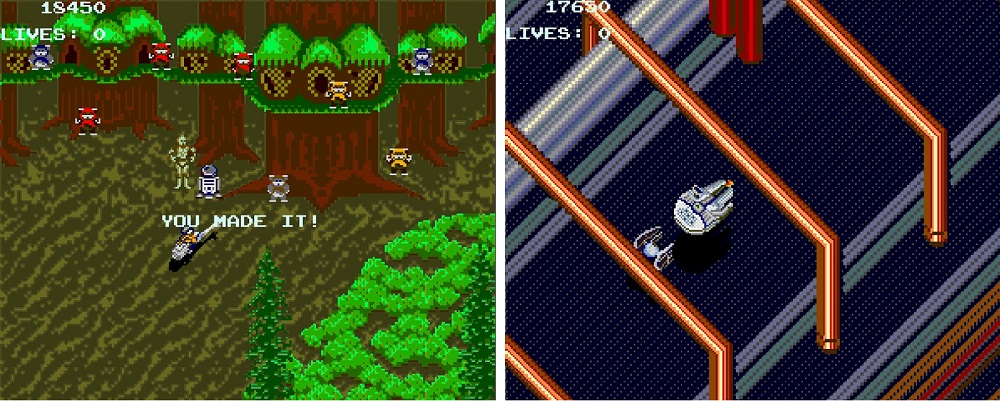
The structure remains similar, playing the same levels in a loop with each wave getting harder. This time around we have a speeder bike chase on Endor, the Millenium Falcon’s Death Star run, and then escape from the Death Star as it explodes. There are a couple more levels on higher difficulties but they are essentially the same: diagonally scrolling levels while you avoid obstacles. With the raster graphics it's more reminiscent of the Indiana Jones and the Temple of Doom arcade game (Atari, 1985), which also has this structure, than the Star Wars arcade game. Perhaps they learned lessons from Jedi, as Indy’s outing was much more enjoyable.
Even on the easiest first levels, it’s infuriating. It might be fun if it was 50% slower, with the levels careening past you faster than you can react. Most of the game is avoiding these obstacles rather than shooting baddies, and it’s not fun at all. I doubt that I had the reflexes to beat this game even as a kid in the arcade after three Coca Colas, and it’s not just me, this is a common complaint. The only way to win is to memorise the levels, and I doubt many kids with a lot of coins weighing them down are going to waste them memorising 10 seconds of Endor forest at a time.
And it gets worse; I gave up before the later levels, in which the game quickly cuts between two separate fast-scrolling levels every few seconds, as if it wasn’t fast enough for your brain to cope with already. With only three lives, it quickly gets tiresome and unlike the other entries, you never Game Over from overwhelming odds, but instead because you hit a tree or small piece of wall.
It’s not hard to see why this didn’t do as well as its predecessor, even if the fancy graphics may have been a draw, there’s no way I would have battled through this when I could go and sit in an X-Wing and blast bad guys. Another factor may have been ‘Atari Shock’, a.k.a. The video game crash of 1983, both the home video game market and the arcades found financial trouble. As a silver lining though, the fall of video games from grace around this time would influence Atari in their next Star Wars game.
Star Wars: The Empire Strikes Back
Atari, 1985
To cut costs and attempt to increase sales to arcades, Empire was produced as a conversion kit for the original Star Wars arcade game. Cheaper than buying a new cabinet, arcades could upgrade their old machine to the new game instead. This would have been easier and cheaper to create for Atari as well, simply repurposing the old game, so this means we’re back to vector graphics. In fact you’d be hard pressed to tell the difference between Star Wars and Empire from a distance despite the changes.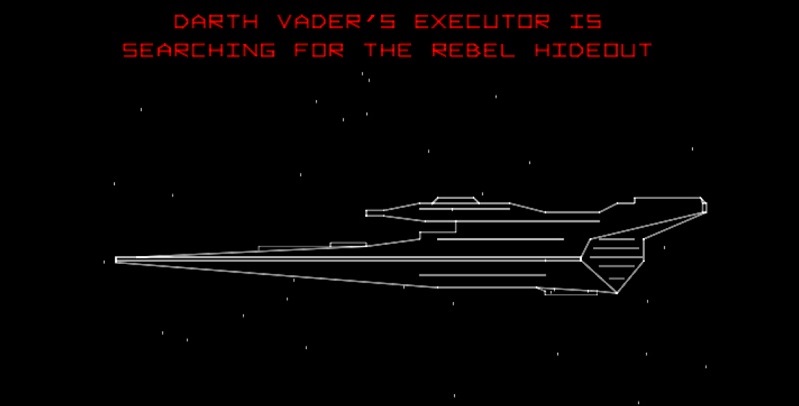
This time around we are on the ice planet Hoth, shooting probe droids and then AT-ATs from your snowspeeder. Next up we’re back in space, this time piloting the Falcon against TIE Fighters and finally then avoiding asteroids. It’s good fun, and this time we have a few more features. You can now move around horizontally instead of being guided around by the game, giving a much greater feeling of being a hotshot pilot. There are also new indicators on the screen for level progress, and special J-E-D-I letters given out for completing tasks in each level. You also get bonuses for things like flying between the legs of an AT-AT. It’s cool. You even shoot tow cables at the AT-ATs just like in the movie, but functionally they’re just missiles. You’ll have to wait until Star Wars: Shadows of the Empire (Lucasarts, 1996) for fully functional tow cables.
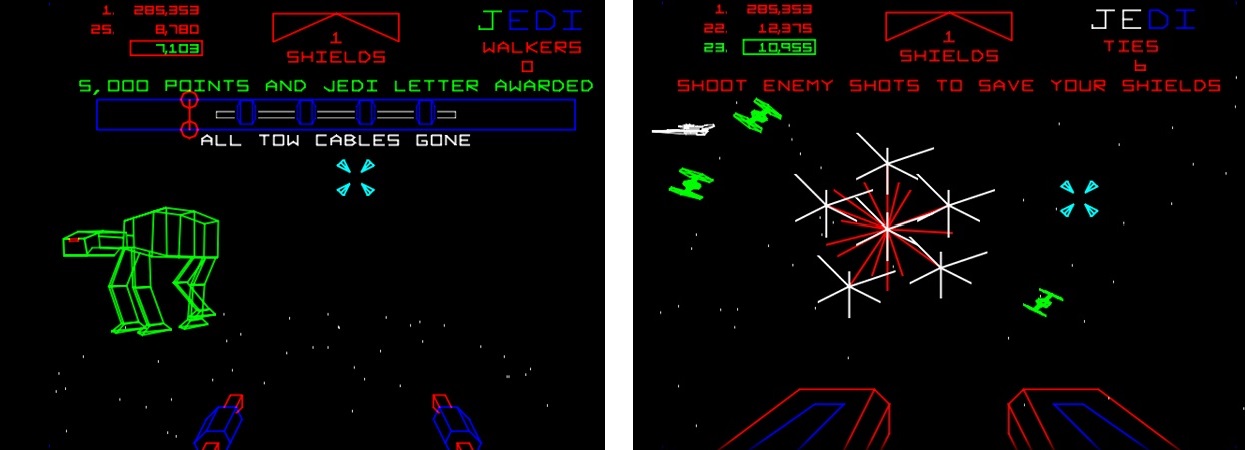
However, Atari’s plan didn’t really pan out. Despite good reviews, if arcades had Star Wars cabinet doing well, why would they risk replacing it? On top of that, this was one of the last vector games produced, with most other games now featuring much fancier raster graphics than Jedi had the year before such as Gauntlet, Paperboy and Hang On, all released in 1985. There was also no new movie to tie-in with, the Empire film itself now being 5 years old.
It was not a great commercial success, and so the licence was laid to rest.
Star Wars Arcade
Sega, 1993
Somehow, Star Wars arcade games returned. Eight years after Empire, arcade games and home computing have weathered the storm of Atari Shock and come out the other side stronger than ever. Street Fighter II (Capcom, 1991) drove people back to the arcades and the 3D revolution was underway with titles like Ridge Racer (Namco, 1993). At this point the arcade game industry in North America was larger than the home console industry and even making more money than Hollywood.
Home video games were more complex too. Fully featured space simulator Star Wars: X-Wing came out on PC in 1993, and at first glance, the screenshot could be of that game. But if you didn’t have a PC, or if you preferred sitting down in an arcade cabinet and pretending you’re a hot shot pilot, then Star Wars Arcade was as close as you could get. In 1994, a Sega 32X version was released, so amateur starfighter pilots with both a Sega Genesis and a 32X expansion unit, could get in on the action. This was almost no one.
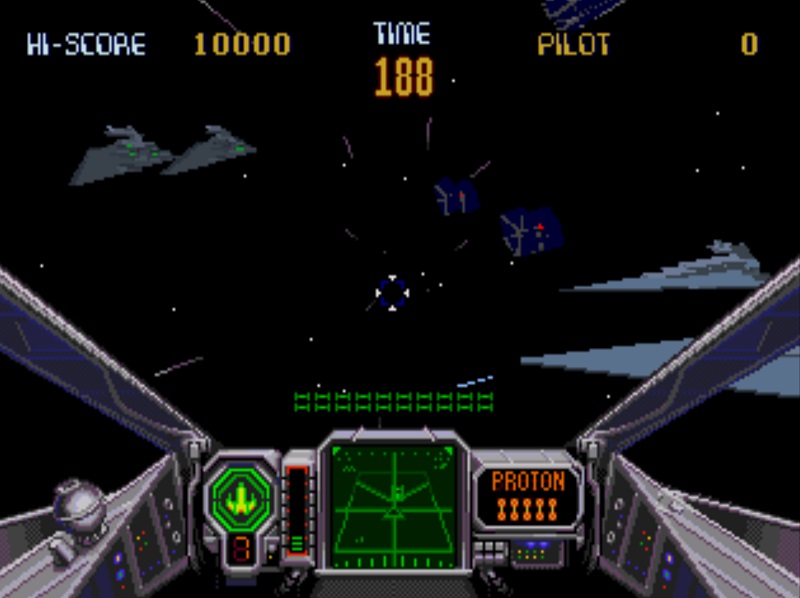
X-Wing on the PC gave players a full 6-degrees of freedom to fly around in a huge swathe of space. It had deep lore and storyline, as well as an energy management system affecting your speed, weapons and shields. SWA is much more of an arcade game; you can move around 360 degrees on the horizontal, with a little bit of leeway up and down for aiming around a small arena a bit like Empire. You can also speed up, slow down, and you also get infinite proton torpedoes which regenerate over time.
I played the 32X version which was much easier than the brutal arcade game, and had more levels. Apart from additional TIE shooting galleries, it also adds a trench run level from A New Hope on top of the existing Super Star Destroyer run and Return of the Jedi death star run of the arcade game. The blasting is satisfying but it doesn't have the charm of the old vector games or the bombast (bombad?!) of the arcade games to follow.
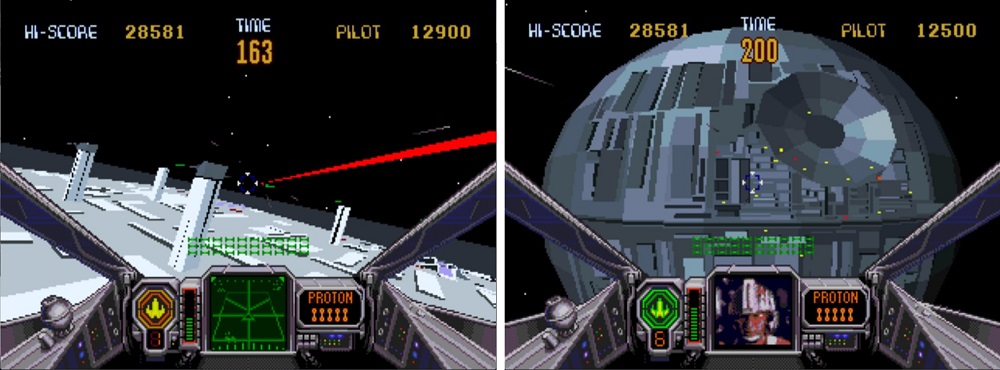
This was the era of 3D racing games and lightgun games, lots of big cabinets and fun novelties, and this was no exception. The sit-down cabinet returns, not a full cockpit canopy this time but it can seat both a pilot and a gunner, and as is typical of Lucasfilm’s attention to detail in non-movie projects, if you have a gunner you’ll be in a Y-Wing instead of an X-Wing to accommodate the extra player. The help allegedly makes the game much less difficult, which would have been very welcome. Difficulty levels increase gradually and it’s much harder than the other cockpit arcade games, but it’s also more interesting. There is more to think about moment-to-moment, even if you’re still just holding the trigger down most of the time. You’ll need to control your speed to get enemies in your sights, and keep your eye on the timer and your mission progress.
Still, not being able to fly wherever you want is a bit frustrating if you’re coming from the X-Wing series. You can’t pull off a daring manoeuvre to chase down your enemies and it never really feels like a dogfight. Still, the arcade and console gamers compared to the PC gaming nerds of the 90s (of which I was a proud member) are different audiences.
Star Wars Trilogy Arcade
Sega, 1998
There’s no question to which audience this game was aimed. Whereas the others give you at least some bit of movement as you aim, SWTA is a proper on-rails shooter: you go where the screen goes and you only control the on-screen target reticule. What sets it apart from the others is that aside from the cockpit levels there are also some light-gun style shooting levels and, as the opening screen of the game reveals, some lightsaber fighting as well.

The usual suspects are present and correct: Battle of Yavin, trench run, speeder bike level and the Battle of Hoth. The shooting sections are a bit of fun in the era of Time Crisis (Namco, 1995) and The House of the Dead (Sega, 1996). Not as fun as using a light gun, but some welcome variety. The joystick does feel a bit more believable as the hilt of a lightsaber, however, and although a bit clunky (maclunky?!) the idea translates well to the screen. There’s a lot of variety, giving a good sense of value for money while you’re queuing up at the arcade, and it’s still well regarded today.

Shadows of the Empire was released on PC and Nintendo 64 in 1996 and has the best rendition of the Battle of Hoth available. It’s a much better recreation, but SWTA’s version is arcade through and through. No time for tow cables, not even the simple ones of Empire, just non-stop action. This and the first-person Hoth level really make it reminiscent of Shadows of the Empire, but it also boasts the best trench run of all the games. Difficulty-wise it’s the easiest of all six games, I feel like it wants you to see the end and experience all the fun it has to offer. Just keep blasting and enjoy the show.
Star Wars Battle Pod
Bandai Namco, 2014
Blasting is the name of the game in 2014’s Battle Pod as well, like SWTA cranked up to 11 while sitting in an exploding photo booth. The titular pod is not the one of Anakin Skywalker’s pod racers, but an enclosed arcade cabinet with a wraparound curved screen inside to make you really feel part of the action.
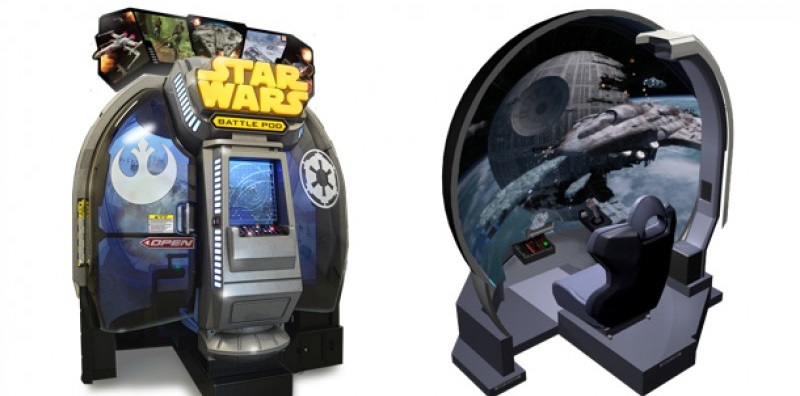
It’s pure adrenaline rush throughout the scenes, and feels more like a theme park simulator ride than an arcade game, zooming around while you try to keep up. It feels much more cinematic as well, with slow motion explosions and the familiar Star Wars music pumping through every level. It’s the step up in maturity you would expect after a 16 year break.
The shooting is more satisfying than SWTA and you can’t simply hold the trigger down like previous games, now that your weapons will quickly overheat. Judicious use of your lasers is now the order of the day, letting them cool down when the enemy is not in your sights.

It only takes a breath in certain moments, when there are enemies that take an age to destroy, most of these are in the Endor speeder section but they are dotted around as mini boss battles. It’s a minor criticism and perhaps it does need the change of pace, but it’s more fun when you’re blasting scores of enemies out of the sky rather than whittling down a health bar.
The trench run can’t quite beat STWA’s version, but you will be wowed by some amazing space acrobatics as you speed through your fleet during the battles without a second to rest. It recreates the scenes from the movies fantastically, and then some. Once you’ve finished the scenes from the films, there is a secret mission created for this game which is immense fun and exciting for the little nugget of story as well as the extra couple of minutes blasting.
The Saga Continues
For sheer fun, Trilogy and and Battle Pod can’t be beaten. While ultimately PC games win out in the end, the best of them owe everything to these arcade games. The through-line right from the very first one is obvious if you’ve played any of the X-Wing or Shadows of the Empire.
And it’s not just the pilot simulators. The whole structure of the games, with different play styles in different stages goes right through the 90s in Shadows of the Empire and the Rebel Assault series (Lucasarts, 1993). Even Super Star Wars games and Indiana Jones’ Greatest Adventures have this lineage, with vehicle sections in between the more standard platforming levels.
Much of Shadows of the Empire is almost a remake of Empire, with both the legendary Hoth level and the TIE and asteroid levels, although with Dash Rendar’s Outrider instead of the Millenium Falcon. It also mixes in completely different third person shooter sections like in Trilogy.

It's a design philosophy that isn’t found in modern games, save for perhaps some on-rails shooter bits riding on the back of a vehicle. Modern game development is expensive and time consuming as it becomes even more complex. It’s hard enough to make a racing game or flight sim or first person shooter that is fun and feels good, let alone all of them in a single game. Without the skill sets, technology or experience in certain genres, an attempt to splice all these genres together today might be doomed to failure. Certainly it will balloon the cost, and give the marketing department a tougher job to communicate it to consumers, which is sadly a big concern for games studios lives today, especially for big licences like Star Wars.
Losing this type of game is a shame, but what that focus can bring is perfect execution of the genre of choice. The first level of Star Wars can be traced through all these arcade games and into the deep and rewarding X-Wing series of flight sims, right up to Star Wars: Squadrons (Motive Studio, 2020) 37 years later.
I can only imagine how much of my pocket money would have disappeared into the original Star Wars and Empire cabinets if I was of arcade age when they were out. I definitely lost a big chunk of change to Trilogy whenever I snuck off to the arcade without my parents’ knowledge.
In the words of 90’s arcade owners everywhere: “You’re all clear kid, now let’s blow your allowance and go home.”

All game posts:
© P7uen 2023 | Base style css by EGGRAMEN 2020